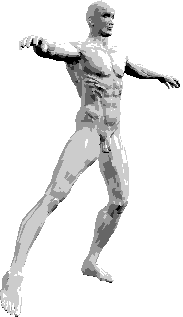Three Ovals -- Head, Ribcage, Pelvis

There are three relatively rigid oval shapes in the body.
Looking at the posing model, it's hard to imagine the two separate ovals of the ribcage and pelvis, which makes beginners want to draw like this:
The influence of the two separate ovals is so powerful, I'm going to try extra hard to convince you that separating the torso into two parts, like this, is VERY IMPORTANT:
Here is a diagram of a skeleton bending sideways (lateral bending):
Lateral bending, extension, and flexion in the spine will produce dramatic change in the surface view of the torso. The illustration below displays the influence of lateral bending and twisting:
1:
With lateral bending in the spine, the angle of the ribcage can be dramatically different from the angle of the pelvis. Knowing this, you can organize the anatomy better around these independent angles.2:
The exterior contour-center-lines on the front of the body and the spine will show shifting direction in accordance with the bends and twists between pelvis and ribcage.3:
With side bending and twisting you see compression on one side, and on the other side, stretching. Notice the deeper folds in the waist on the left, and the simpler, longer, straight line on the right side of the waist. Also, notice how the rib cage protrudes on the stretched side, but tucks out of view on the compressed side.
Gesture Intro Page